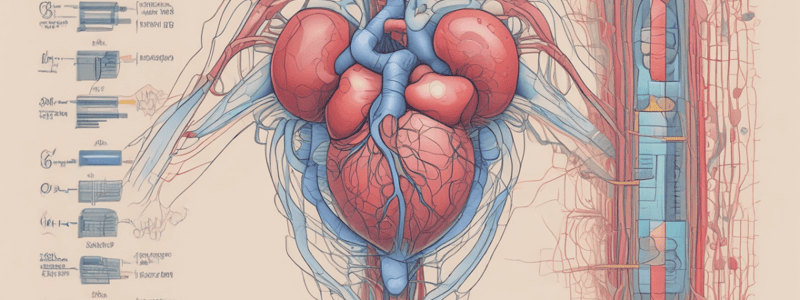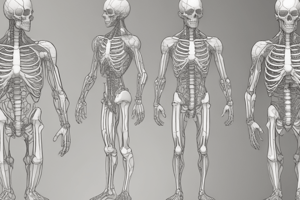Podcast
Questions and Answers
What is the primary goal of the body's response to septicemia?
What is the primary goal of the body's response to septicemia?
- To increase cardiac output
- To increase cortisol levels
- To maintain blood volume and perfusion of vital organs (correct)
- To reduce blood pressure
What is a characteristic of hepatic dysfunction in severe sepsis?
What is a characteristic of hepatic dysfunction in severe sepsis?
- Reduced cortisol levels
- Elevated bilirubin levels (correct)
- Decreased liver enzyme levels
- Increased glucose production
Which of the following is a sign of severe sepsis?
Which of the following is a sign of severe sepsis?
- Decreased heart rate
- Acute alteration in mental status (correct)
- Increased cortisol levels
- Increased blood pressure
What is a key characteristic of septic shock?
What is a key characteristic of septic shock?
Which of the following is NOT a criterion for diagnosing SIRS?
Which of the following is NOT a criterion for diagnosing SIRS?
What is the result of inadequate cardiac output in septicemia?
What is the result of inadequate cardiac output in septicemia?
What is the primary cause of lactic acid production in septicemia?
What is the primary cause of lactic acid production in septicemia?
What is the result of severe sepsis?
What is the result of severe sepsis?
Which of the following is a consequence of decreased cardiac output in septicemia?
Which of the following is a consequence of decreased cardiac output in septicemia?
What is the primary mechanism of cellular injury in septic shock?
What is the primary mechanism of cellular injury in septic shock?
Which of the following is a clinical manifestation of severe sepsis?
Which of the following is a clinical manifestation of severe sepsis?
What is the primary function of cortisol in the response to septicemia?
What is the primary function of cortisol in the response to septicemia?
What is the consequence of inadequate tissue perfusion in septicemia?
What is the consequence of inadequate tissue perfusion in septicemia?
Which of the following is a criterion for diagnosing SIRS?
Which of the following is a criterion for diagnosing SIRS?
What is the consequence of excessive cortisol production in septicemia?
What is the consequence of excessive cortisol production in septicemia?
Which of the following is a complication of severe sepsis?
Which of the following is a complication of severe sepsis?
What is the primary mechanism by which the body responds to septicemia?
What is the primary mechanism by which the body responds to septicemia?
What is the primary cause of decreased cardiac output in septicemia?
What is the primary cause of decreased cardiac output in septicemia?
What is the primary consequence of inadequate tissue perfusion in septicemia?
What is the primary consequence of inadequate tissue perfusion in septicemia?
What is the primary role of cortisol in the response to septicemia?
What is the primary role of cortisol in the response to septicemia?
What is the primary criterion for diagnosing septic shock?
What is the primary criterion for diagnosing septic shock?
What is the primary consequence of lactic acid production in septicemia?
What is the primary consequence of lactic acid production in septicemia?
What is the primary mechanism of cellular injury in septicemia?
What is the primary mechanism of cellular injury in septicemia?
What is the primary outcome of septicemia?
What is the primary outcome of septicemia?
What is the primary physiological response to maintain blood volume in septicemia?
What is the primary physiological response to maintain blood volume in septicemia?
What is the primary consequence of decreased oxygen supply in septicemia?
What is the primary consequence of decreased oxygen supply in septicemia?
What is the primary criterion for diagnosing SIRS in the context of septicemia?
What is the primary criterion for diagnosing SIRS in the context of septicemia?
What is the primary consequence of inadequate tissue perfusion in septicemia?
What is the primary consequence of inadequate tissue perfusion in septicemia?
What is the primary role of adrenaline in the response to septicemia?
What is the primary role of adrenaline in the response to septicemia?
What is the primary characteristic of septic shock?
What is the primary characteristic of septic shock?
What is the primary consequence of excessive cortisol production in septicemia?
What is the primary consequence of excessive cortisol production in septicemia?
What is the primary clinical manifestation of severe sepsis?
What is the primary clinical manifestation of severe sepsis?
Flashcards are hidden until you start studying
Study Notes
SIRS and Septic Shock
- SIRS (Systemic Inflammatory Response Syndrome) is the clinical presentation of widespread inflammation resulting from various insults, including trauma, burns, and pancreatitis.
- SIRS requires evaluation of temperature, heart rate, respiratory rate, and white blood cell count.
- Organ dysfunction is a key feature of severe sepsis.
Organ Dysfunction
- Hepatic dysfunction: bilirubin >34 µmol/l and high liver enzyme levels.
- Mental/brain dysfunction: acute alteration in mental status.
- Other organ dysfunction can occur, including cardiac, renal, and respiratory.
Septic Shock
- Characterized by decreased blood pressure (BP) and decreased blood perfusion.
- Decreased oxygen (O2) supply leads to increased lactic acid production.
- Increased stress and glucose levels are also observed.
Pathogenesis
- Inadequate cardiac output and decreased blood pressure lead to tissue perfusion and cell death.
- Cortisol, GH, and adrenaline play a role in the pathogenesis of septic shock.
Clinical Manifestations
- Purpura is a clinical manifestation of septic shock.
- Shock, inadequate cardiac output, and decreased blood pressure can lead to organ failure and death.
- Fluid loss and decreased blood volume can worsen outcomes in septicemia.
SIRS and Septic Shock
- SIRS (Systemic Inflammatory Response Syndrome) is the clinical presentation of widespread inflammation resulting from various insults, including trauma, burns, and pancreatitis.
- SIRS requires evaluation of temperature, heart rate, respiratory rate, and white blood cell count.
- Organ dysfunction is a key feature of severe sepsis.
Organ Dysfunction
- Hepatic dysfunction: bilirubin >34 µmol/l and high liver enzyme levels.
- Mental/brain dysfunction: acute alteration in mental status.
- Other organ dysfunction can occur, including cardiac, renal, and respiratory.
Septic Shock
- Characterized by decreased blood pressure (BP) and decreased blood perfusion.
- Decreased oxygen (O2) supply leads to increased lactic acid production.
- Increased stress and glucose levels are also observed.
Pathogenesis
- Inadequate cardiac output and decreased blood pressure lead to tissue perfusion and cell death.
- Cortisol, GH, and adrenaline play a role in the pathogenesis of septic shock.
Clinical Manifestations
- Purpura is a clinical manifestation of septic shock.
- Shock, inadequate cardiac output, and decreased blood pressure can lead to organ failure and death.
- Fluid loss and decreased blood volume can worsen outcomes in septicemia.
SIRS and Septic Shock
- SIRS (Systemic Inflammatory Response Syndrome) is the clinical presentation of widespread inflammation resulting from various insults, including trauma, burns, and pancreatitis.
- SIRS requires evaluation of temperature, heart rate, respiratory rate, and white blood cell count.
- Organ dysfunction is a key feature of severe sepsis.
Organ Dysfunction
- Hepatic dysfunction: bilirubin >34 µmol/l and high liver enzyme levels.
- Mental/brain dysfunction: acute alteration in mental status.
- Other organ dysfunction can occur, including cardiac, renal, and respiratory.
Septic Shock
- Characterized by decreased blood pressure (BP) and decreased blood perfusion.
- Decreased oxygen (O2) supply leads to increased lactic acid production.
- Increased stress and glucose levels are also observed.
Pathogenesis
- Inadequate cardiac output and decreased blood pressure lead to tissue perfusion and cell death.
- Cortisol, GH, and adrenaline play a role in the pathogenesis of septic shock.
Clinical Manifestations
- Purpura is a clinical manifestation of septic shock.
- Shock, inadequate cardiac output, and decreased blood pressure can lead to organ failure and death.
- Fluid loss and decreased blood volume can worsen outcomes in septicemia.
SIRS and Septic Shock
- SIRS (Systemic Inflammatory Response Syndrome) is the clinical presentation of widespread inflammation resulting from various insults, including trauma, burns, and pancreatitis.
- SIRS requires evaluation of temperature, heart rate, respiratory rate, and white blood cell count.
- Organ dysfunction is a key feature of severe sepsis.
Organ Dysfunction
- Hepatic dysfunction: bilirubin >34 µmol/l and high liver enzyme levels.
- Mental/brain dysfunction: acute alteration in mental status.
- Other organ dysfunction can occur, including cardiac, renal, and respiratory.
Septic Shock
- Characterized by decreased blood pressure (BP) and decreased blood perfusion.
- Decreased oxygen (O2) supply leads to increased lactic acid production.
- Increased stress and glucose levels are also observed.
Pathogenesis
- Inadequate cardiac output and decreased blood pressure lead to tissue perfusion and cell death.
- Cortisol, GH, and adrenaline play a role in the pathogenesis of septic shock.
Clinical Manifestations
- Purpura is a clinical manifestation of septic shock.
- Shock, inadequate cardiac output, and decreased blood pressure can lead to organ failure and death.
- Fluid loss and decreased blood volume can worsen outcomes in septicemia.
Studying That Suits You
Use AI to generate personalized quizzes and flashcards to suit your learning preferences.




